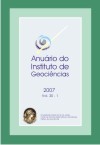Multivariate ecological data analisys from Guanabara bay - RJ, based on benthic foraminifera
DOI:
https://doi.org/10.11137/2007_1_101-108Abstract
Guanabara bay is an estuary environment situated in the seaboard of Rio de Janeiro state, under the coordinates 22º 40' and 23º 00'S and 43º 00' and 43º 20'W. Nowadays, it has an approximate area of 377 km2, it has had a reduction of 91 km2 since the discovery of Brazil, being considered one of the most polluted seacoast regions of the country. The environmental monitoring of Guanabara bay becomes increasingly necessary in order to be capable of taking effective measures in its management. Therefore, the use of bioindicator organisms, like foraminifera, is an excellent tool because of their rapid response to environmental changes. The goal of this paper is to apply statistical analyses to the biotic data (benthic foraminifera), aiming to observe how they behave in Guanabara bay. In November 1999, samples of bottom sediment were collected along Guanabara bay; 52 of them distributed along all the bay were used in this study. They were treated and classified according to the pattern methodology for foraminifera. For the numerical ecology, grouping analysis and indicating species analysis (ISA) were done using the programs Statistica 6.0 and PCORD. Through the grouping analysis, it was observed the formation of groups in both samples and species. ISA showed what species is the best one to indicate the actual state of Guanabara bay - Ammonia tepida. The multivaried ecological analyses had an optimal response in the evaluation of patterns of pollution in Guanabara bay, based on benthic foraminifera.Downloads
Download data is not yet available.
Downloads
Published
2007-01-01
How to Cite
Santos, P. T. dos (2007) “Multivariate ecological data analisys from Guanabara bay - RJ, based on benthic foraminifera”, Anuário do Instituto de Geociências. Rio de Janeiro, BR, 30(1), pp. 109–115. doi: 10.11137/2007_1_101-108.
Issue
Section
Article
License
This journal is licensed under a Creative Commons — Attribution 4.0 International — CC BY 4.0, which permits use, distribution and reproduction in any medium, provided the original work is properly cited.















